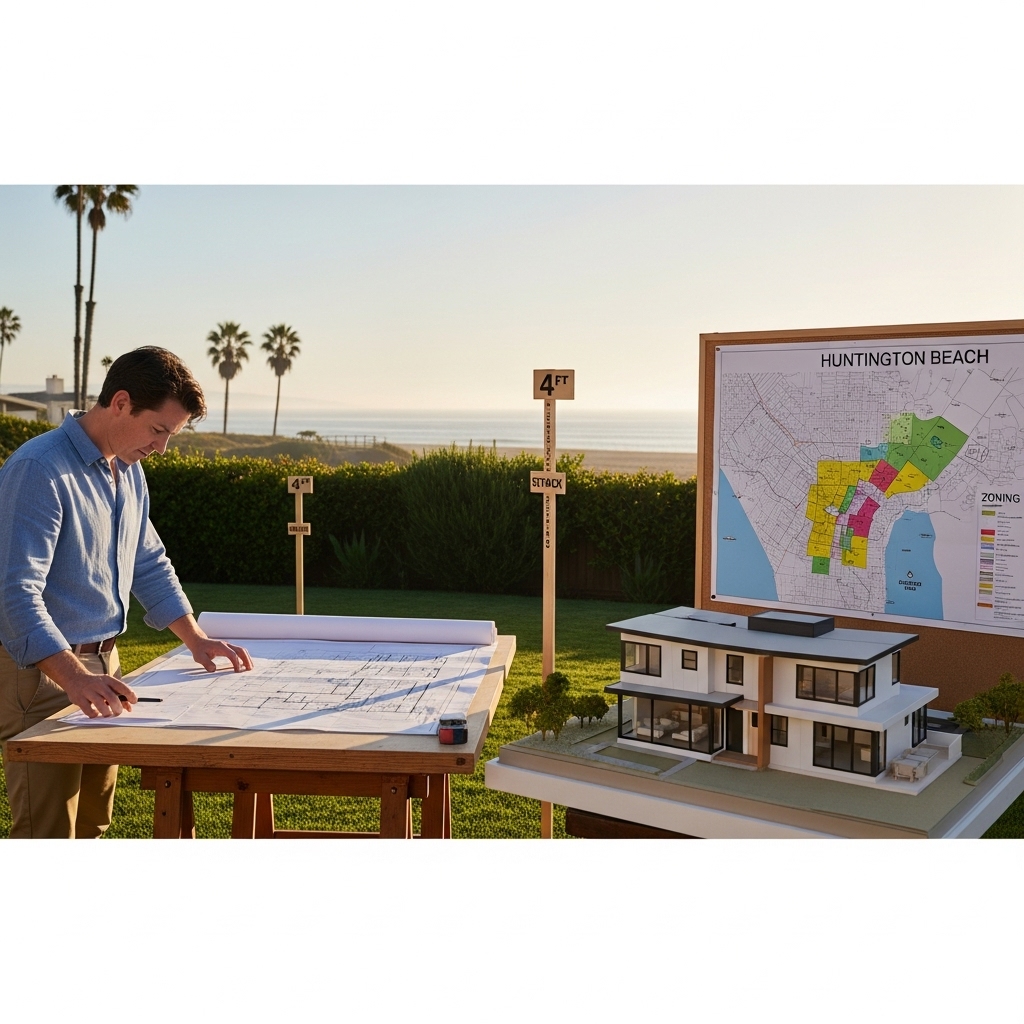Planning an accessory dwelling unit in Huntington Beach is exciting, but understanding the rules is essential before you sketch floor plans or contact a builder. California has strong statewide laws that make building an ADU easier, but every city—including Huntington Beach—implements those rules through local ordinances, zoning standards, and administrative procedures. This guide walks you through the fundamentals: state baselines, local zoning, setbacks, height, parking, utilities, coastal considerations, and how to prepare a compliant submittal the first time.
How State Law Shapes Local ADU Rules
Since 2017, California has passed multiple bills to streamline ADUs. The most important takeaways for homeowners are predictability and speed. ADU approvals must be ministerial—no discretionary hearings or subjective design reviews—and the city must complete its review within a defined time window. The state also sets minimum thresholds for size, setbacks, parking, and fees to ensure a basic pathway exists on most parcels.
- Ministerial review: Huntington Beach must review complete ADU applications within a short, clear timeline. If corrections are needed, they must be objective and tied to code.
- Guaranteed buildability: An ADU of up to 800 square feet, 16 feet in height, with four-foot side and rear setbacks must be allowed, regardless of lot coverage or floor area ratio limits that would otherwise apply.
- No lot minimums: You do not need a large lot to qualify; ADU eligibility is based on zoning and existing residential use, not a minimum lot size.
- Impact fee protections: Impact fees cannot be charged for ADUs under 750 square feet. Above that, fees must be proportionate to the size of the ADU compared to the primary dwelling.
State law also distinguishes between detached ADUs, attached ADUs, and junior ADUs (JADUs). While many rules apply broadly, a few items—such as utility connections and owner occupancy—vary by type. Understanding those distinctions helps you select the best path for your property.
Zoning and Where ADUs Are Allowed in Huntington Beach
Most single-family and multifamily residential zones in Huntington Beach permit ADUs by right, subject to objective standards. If your property has an existing or proposed single-family dwelling, you can generally add one ADU and one JADU, provided you meet setbacks, height, and other development standards. For multifamily properties, conversions of non-livable spaces to multiple ADUs and the construction of detached ADUs are often possible within state caps.
Always confirm whether your parcel is within the coastal zone, near environmentally sensitive habitat, or part of a planned community with recorded CC&Rs. While homeowners associations cannot prohibit ADUs outright, they may enforce reasonable architectural rules that still comply with state law. In the coastal zone, additional findings or permits may be required to address shoreline and resource protection.
Setbacks: The Four-Foot Rule and Existing Structures
Setbacks can determine what is possible in a rear yard. State law requires cities to allow side and rear setbacks as small as four feet for a new detached ADU. If you convert an existing permitted structure—like a garage or pool house—you may keep the structure’s existing setbacks. Replacement of an existing structure in the same footprint typically may continue the nonconforming setbacks when converted to an ADU, though life-safety upgrades still apply.
- New detached ADUs: Minimum four-foot side and rear yard setbacks must be allowed.
- Attached ADUs: Must comply with attached standards, but state law still protects an 800-square-foot, four-foot setback option with a 16-foot height allowance.
- Corner and flag lots: Lot geometry can change how setbacks apply at the street side; check the city’s definitions of front, side, and rear yards.
For lots with easements, utility corridors, or special overlays, verify any additional buffers or restrictions early so your design can accommodate them.
Height and Massing: State Minimums and Local Nuance
State law requires an allowance for at least a 16-foot-high ADU—sufficient for many single-story designs with a pitched roof. In certain situations allowed by state law, heights may reach approximately 18 to 25 feet, particularly when attached to the primary dwelling or near qualifying transit. Huntington Beach may tailor these allowances to neighborhood contexts, but it cannot reduce the state baseline. Where a two-story detached ADU is feasible, privacy modulation—such as upper-story step-backs, window placement, and screening—is often used to address neighbor concerns while staying within objective standards.
Square Footage and Lot Coverage
While some zones control lot coverage, floor area ratio, or open space, state law provides a safety valve: an 800-square-foot ADU must be permitted regardless of these caps, provided you meet the four-foot setbacks and the minimum height standard. Many homeowners design between 400 and 1,000 square feet, balancing livability and site constraints. For attached ADUs, a percentage of the primary dwelling’s floor area may apply, but not in a way that reduces the guaranteed 800 square feet.
Parking: When Spaces Are Required or Exempt
Parking is often simpler than expected. Detached and attached ADUs may require one off-street parking space unless you qualify for an exemption under state law. The most common exemptions include:
- The ADU is within one-half mile walking distance of public transit.
- The ADU is part of a conversion of an existing structure such as a garage or accessory building.
- The ADU is located within an architecturally and historically significant district as defined in applicable law.
- On-street parking permits are required but not offered to the ADU’s occupant.
- A car share vehicle is located within one block.
If you convert a garage to an ADU, the city cannot require that you replace the lost covered parking spaces with new covered spaces. Driveways, tandem spaces, and permeable pavers can often satisfy on-site parking if a stall is required.
Owner Occupancy, Rental Rules, and Use
State law currently prohibits cities from imposing owner-occupancy requirements on newly constructed ADUs for a defined period, while JADUs must have an owner occupant in either the primary dwelling or the JADU. Huntington Beach follows these rules. Long-term rental is allowed; however, short-term rental policies are local. If you plan to rent for terms shorter than a month, verify the city’s short-term rental ordinance for your neighborhood and any HOA restrictions.
Utilities, Fire, and Building Code Essentials
Detached ADUs typically require separate building, electrical, mechanical, and plumbing permits, but junior ADUs have simplified utility rules. If the primary dwelling does not have fire sprinklers, an ADU generally cannot be required to add sprinklers solely because of the ADU, although other triggers—like extensive remodels or distance from fire access—could affect outcomes. Utility connection fees for detached ADUs must be proportionate to the impact of the new unit. Energy compliance, envelope insulation, fenestration limits, and ventilation systems must meet the version of the energy code in effect at the time of permit.
Coastal Zone and Environmental Considerations
Portions of Huntington Beach sit within the coastal zone. In these areas, a Coastal Development Permit may be required for new detached ADUs or additions that alter site coverage, grading, or public access. Coastal hazards—flooding potential, sea-level rise, and erosion—can influence foundation type, finished floor elevation, materials, and drainage. When you plan in the coastal zone, add time for coastal review and assemble a team experienced with coastal permitting and objective design standards that align with the city’s certified Local Coastal Program.
Design Strategies to Meet Objective Standards
Good design choices make approvals smoother and create better living spaces. Use a roof form and exterior palette compatible with the primary home, avoid windows that peer directly into adjacent backyards, and place entries where lighting and noise will not disturb neighbors. Landscape with drought-tolerant planting and consider permeable paving to manage runoff. On tight sites, push storage and laundry into built-ins to preserve open floor area and circulation.
- Privacy: Use clerestory windows, frosted glazing at bathrooms, and landscape screens where setbacks are tight.
- Light and air: Higher ceilings, operable windows on multiple orientations, and skylights improve comfort without enlarging the footprint.
- Noise: Separate bedrooms from shared fences and use resilient channels or sound attenuation where walls are near neighboring patios.
Submission, Timelines, and Corrections
Prepare a complete submittal package to hit the city’s ministerial timelines. Typical components include site plan, floor plans, elevations, sections, roof plan, Title 24 energy documentation, structural details or calculations if needed, and notes that address zoning standards. In the coastal zone, include any required coastal forms or studies. If the city issues corrections, they must be objective. Respond clearly and completely to keep the review moving and avoid resets of the review clock.
Common Pitfalls to Avoid
- Ignoring easements and utilities: Call for utility markouts and confirm easements that could limit placement.
- Overlooking drainage: New impervious area may require on-site retention or specific drainage paths to the street.
- Rushing the survey: On irregular lots, an accurate boundary and topographic survey can save weeks of redesign.
- Forgetting fire access: Long flag lots or locked gates can trigger special requirements for fire department access paths.
- Underestimating coastal review: If you are in the coastal zone, plan for additional documentation and processing time.
Middle-Mile Planning Tips
As your design matures, check how your selections affect code compliance and long-term maintenance. Durable exterior cladding, corrosion-resistant fasteners, and proper roof overhangs are especially important in the coastal environment. If you are considering solar, battery storage, or an EV-ready garage bay, coordinate service sizes and panel locations early to avoid costly relocations later. When in doubt, consult the city’s ADU handouts and talk with an experienced local team; a well-planned accessory dwelling unit is smoother to permit and more enjoyable to live in.
FAQs
Q: Can I build a two-story ADU in Huntington Beach? A: If your lot, zone, and height standards allow, a two-story design may be permitted. State law sets minimum height allowances, and local standards may allow taller structures in certain contexts. Privacy, step-backs, and window placement often guide approval.
Q: Do I need to provide parking? A: Many projects are exempt, especially if within one-half mile of public transit or if converting an existing garage or accessory structure. If required, one space is typical and can often be tandem or uncovered.
Q: Are ADUs allowed in the coastal zone? A: Yes, but you may need a Coastal Development Permit and must comply with the Local Coastal Program. Expect added attention to hazards, drainage, and public access.
Q: Will I need fire sprinklers? A: If the primary dwelling does not have sprinklers, the ADU generally cannot be required to add them solely because of the ADU, though other triggers may apply. Coordinate with the building and fire departments.
Q: Can I rent my ADU short-term? A: Long-term rentals are allowed. Short-term rentals depend on city rules and may be restricted by neighborhood and HOA policies. Verify the latest local ordinance.
Q: What is a JADU? A: A junior ADU is a smaller unit created within the footprint of the existing single-family home, often by converting a bedroom. JADUs have unique rules for kitchens, access, and owner occupancy.
Q: How long does approval take? A: Ministerial reviews are designed to be faster than traditional approvals. Turnaround depends on the completeness of your plans and whether the project is in the coastal zone.
Ready to Plan Your Huntington Beach ADU?
If you want a clear, code-aligned path from feasibility to final inspection, assemble a local team that understands Huntington Beach zoning, the coastal zone, and California’s ADU statutes. Start with a feasibility study, confirm setbacks and height, and shape a design that is comfortable, durable, and neighbor-friendly. When you are ready to take the next step, connect with experienced professionals who can develop permit-ready drawings and coordinate submittals for you—your future residents will thank you. For guidance from concept through permits and construction, reach out to an experienced ADU design-build partner and move forward with confidence.

